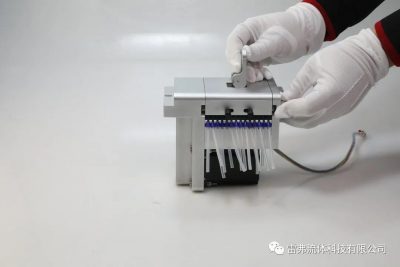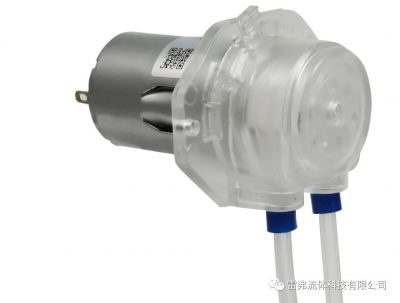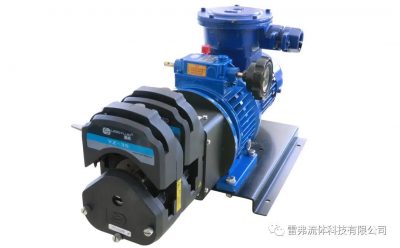Lead Fluid specializes in the development, production and sales of peristaltic pumps for more than ten years. Based on our own technical experience and customer feedback, we have summarized the following points for attention in the use of peristaltic pumps in order to improve their work efficiency and enthusiasm.
01 When the peristaltic pump is not working, loosening the pressure block can extend the life of the pump tube. The peristaltic pump uses the pump head rollers to repeatedly squeeze the hose and the natural rebound of the hose to generate suction to achieve fluid delivery. If you want to maintain the long life of the pump tube, when the pump is not in use, try to lift the pump head pressure block to make the pump tube in a natural uncompressed state, thereby extending the life of the pump tube.
02 When selecting the peristaltic pump, under the premise of meeting the customer’s flow requirements, reduce the pump speed to less than 300 rpm as much as possible. The flow of the peristaltic pump is produced by the rotation of the pump head roller. The faster the rotation, the shorter the service life of the pump tube. When you want the pump tube to last longer, you can choose a relatively larger tube diameter to reduce the pump rotating speed.
03 The pump head uses a special tube for the peristaltic pump, and the other connecting tube use ordinary tube. Extrusion tubes used in peristaltic pumps require good compression, resilience, and tear resistance. Therefore, the material purity of these pump tubes is relatively high, and the wall thickness and shape accuracy are high, which will result in higher prices for peristaltic pump tubes. Therefore, special tube are used on the peristaltic pump to ensure the service life, and the connecting tube are ordinary tube, making the entire system more economical.
04 The inlet tube of the peristaltic pump should be as short as possible, and the joint and diameter of the tube should not be lower than the tube diameter of the pump head. The suction force of the peristaltic pump is produced by the rebound of the pump tube. If the pipeline, especially the inlet pipeline, is too long or the diameter becomes smaller, it will cause excessive resistance at the suction end. If the resistance is too large, the rebound of the pump tube will be blocked, so the actual delivery traffic will suffer a great loss. In the same way, if the diameter of the outlet tube becomes smaller or the pipeline is too long, the discharge pressure of the peristaltic pump is usually small. When the discharge resistance is too large, the output flow will decrease.
05 When selecting a peristaltic pump, the theoretical flow rate should be greater than the actual flow rate, preferably greater than 30%. The peristaltic pump tube is relatively soft, so the negative pressure and discharge pressure generated by it are small. If the conveyed liquid has a certain viscosity or the pipeline has a certain length, it will cause the loss of the actual flow. In order to achieve the required flow. When selecting the model, the theoretical flow rate should be slightly higher than the actual flow rate.
06 The peristaltic pump should pay attention to cleaning up the debris on the pump casing and pump tube during use. Because the peristaltic pump is a relatively precise instrument, it mainly relies on the pump casing to maintain a high-precision gap, so as to efficiently squeeze the pump tube. If the pump tube is damaged and the inflowing liquid adheres to the pump casing roller, pressure block and pump tube. It will change the compression gap of the pump head, even a small change will cause excessive premature wear of the pump tube, which will seriously affect the pump head and cause damage to the pump head.
07 When using the peristaltic pump, check the wear of the pump tube regularly. Because the peristaltic pump tube is a vulnerable part, once it is damaged, it will cause liquid leakage. Therefore, it is necessary to check the surface of the pump tube in time for early grinding holes to prevent damage.
08 When choosing a peristaltic pump, pay attention to whether the liquid to be transported will corrode the pump tube. Because pump pipes are made of many materials and transported liquids are also very many, no pump pipe can withstand all liquids, so you need to confirm your own liquid type, compare the chemical compatibility table or ensure the pump pipe through immersion experiment can use.
09 The operating temperature range is also an important factor to consider. Different materials have different temperature performance. Some pipes, such as silicone rubber, have a wide temperature tolerance range, which is suitable for both high and low temperature processes, while some pipes are only suitable for a small temperature range. The end user should clarify the max and min temperature in the system before selecting the pipes, to ensure that the selected pump pipes work safely in this temperature range and improve their service life.
Hope the above summary can be helpful to everyone.



